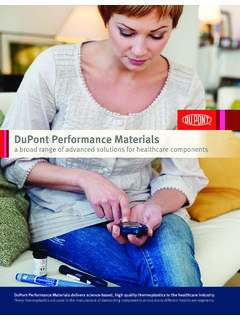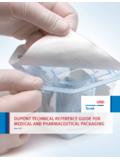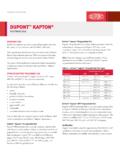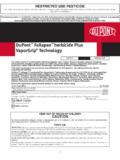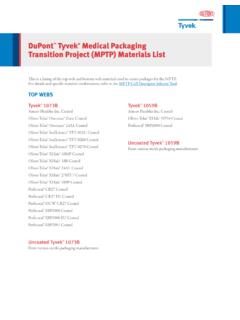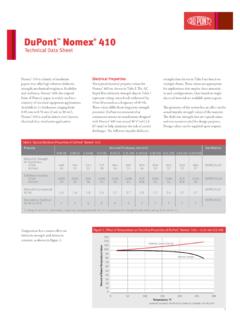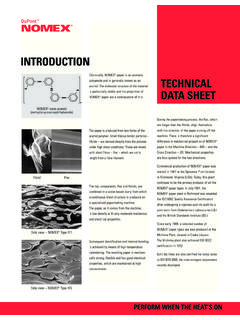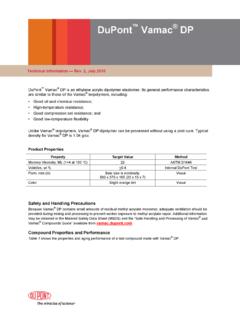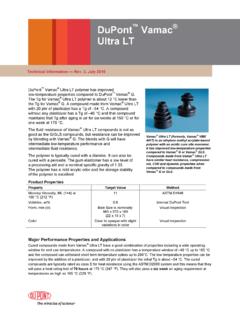Transcription of Advanced WLP Resist Stripping - DuPont
1 Advanced WLP Resist Stripping : Jim Cullen1, Wai Mun Lee2. 1. DuPont EKC Technology Ltd. East Kilbride, G74 4QL, UK 2. DuPont EKC Technology Inc.,2520 Barrington Ct.,Hayward CA 94545-133. Keywords: HDA , UBM, Eutectic, NQD, TMAH, NMP, DMSO. Removal of thick Resist is difficult for traditional solvent Abstract based strippers especially after electroplating This paper outlines the advances made by EKC in developing a solution for WLP Resist Stripping based on the globally established HDA technology. HDA technology has been expanded into WLP to give a solution that out performs traditional Solvent/TMAH blends.
2 Introduction As the package I/O count and bump density on IC's continually increases it follows that the bump pitch , and line space/width must decrease. Consequently the criteria for photoresists in WLP bump formation have become increasingly demanding. Photospeed, resolution, resistance to plating solutions and Resist strippability are important criteria for Resist selection. Napthoquinone diazide (NQD) positive-tone resists, are predominantly used for gold bumping at thicknesses below 50 m. These resists are relatively easy to strip with organic solvents but are unsuitable for Resist thicknesses of 50-120 m.
3 Acrylic negative tone resists fulfil the majority of the criteria for these thicknesses but have been difficult to strip due to 3D. cross-linking, high temperature treatment and reaction with plating solutions. Commercially available Resist Stripping formulations are predominantly DMSO or Fig 1. Incomplete Resist removal with current solvent based strippers. NMP based and incorporate TMAH. These strippers exhibit problems in delivering complete and consistent Formulation Development removal of the resists used in electroplated solder A series of screening experiments identified three bumping.
4 Residual polymer around the bottom of the components with a strong influence of Resist Stripping . bumps and visibly undetectable residue that masks A set of nine multi-component formulations, based on UBM etching, are two common manifestations of these components was generated by a statistical incomplete Stripping . Short bath life is a universal mixture DOE, over the formulation composition shown problem. Compatibility of the stripper with a multitude in Figure 2. of UBM's and bump compositions is essential and S imple x De s ign P lot i n Amounts critical.
5 High Lead content bumps are particularly Co mpo ne nt A. sensitive to chemical attack. This paper will discuss a new approach for the development of suitable strippers for WLP Electroplating bumping applications. 15. Current Resist Stripping Technology Current organic solvent based Stripping solutions have 40. Compone nt B. Co mpo ne nt C. difficulty removing thick, negative tone, acrylic resists Fig 2. Simplex Design from DOE mixture as shown in Figure 1. These simple formulations lack the necessary chemical activity to break down thick, This matrix was extensively tested to determine the heavily crosslinked 3D polymer networks, even at optimum formulation, minimising UBM and solder elevated temperature and prolonged times.
6 Etch but retaining fast and efficient Resist removal. The resultant formulation was EKC108 . Results EKC108 with various resists, UBM's and bump compositions. H2O2/H2SO4. Resist : JSR 151N,(acrylic negative tone Resist ). Bump: Lead Free O2 Plasma (NH4) 2S2O8/H2SO4 Oxidation Fuming Nitric Acid Solvent Stripper SCCO2 Dissolution Alkaline Developer Hydrazine/. H2 Plasma Reduction Hydroxylamine Due to the unique properties of HDA a dissolution mechanism is proposed whereby disproportionation, dissociation and ionisation combine to remove the Fig 3. Complete removal with EKC108 , 25min, 35 C Resist .
7 For thick acrylic negative tone resists this mechanism is particularly effective for the cross-linked acrylic functional groups. Resist : AZ4562 (positive Resist ). Bump: Eutectic PbSn Fig 4. Complete removal with EKC108 , 3mins., 50 C. Resist : JSR124N( negative tone Resist ). Bump:Eutectic PbSn Fig 6. Cross linking of JSR negative tone Resist The Resist is cross-linked after exposure and becomes base insoluble. A principle cleaning mechanism in EKC108 technology is based on the chemical reaction to break down cross linked polymers and form more soluble oximes.
8 Fig 5. Complete removal with EKC108 , 3 mins., 50 C. Technology: Aprotic Solvent - DMSO, Acid/Base . Water, Reactive Hydroxylamine Mechanisms Table 1 Photoresist Stripping mechanisms for IC. manufacturing. Dry Process Wet Process Mechanism Conclusion HDA technology for the removal of WLP resists has been discussed. This technology can be used R1 effectively for Stripping a variety of resists on different substrates with varying UBM and bump compositions. Acknowledgements Oxime Formation Thanks to IZM, Berlin for the provision of substrates The reaction begins with nucleophilic addition to the carbonyl functional group.
9 And bumped wafers. Thanks to Infineon Technologies for their co-operation and provision of test wafers. R1 R1 R1. References The addition product is then protonated and dehydrated. Katsuji Doki , Advances in thick photoresists for flip- chip bumping, Solid State Technology August 2005, p47. R1. JSR, APiA, Semicon West R1 R1. Wai Mun Lee, A proven sub-micron Photoresist Stripper solution for Post Metal and Via Hole processes , 1996. R1 Dr. Richard Pendarvis, CFCC Organic Chemistry 2005. Footnote HDA(r) - Registered Trademark of EKC Technology, Inc. TMAH - Tetramethylammonium hydroxide WLP - Wafer level packaging DMSO - Dimethylsulphoxide NMP - N-Methylpyrrolidone The result is an increased solubility of the product (oxime) formed.
10 The chemical activity imparted to EKC108 through HDA technology greatly improves the ability of the formulation to remove very thick, 50-100 m resists at far lower temperatures and shorter times than conventional offerings. Importantly, HDA . technology also extends the functionality of EKC108 to include Dry Film Resists
